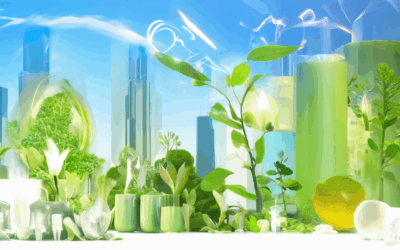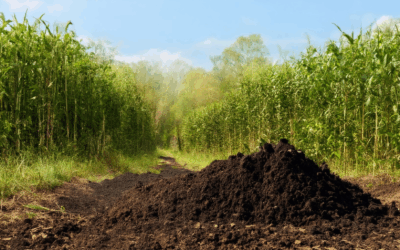Climate-conscious gardening is more than just a trend; it’s a vital approach to sustainable living in our rapidly changing world. As temperatures rise and environmental challenges intensify, adopting eco-friendly gardening practices has become essential for both novice and experienced gardeners alike. By integrating sustainable methods, gardeners can reduce their carbon footprint while cultivating thriving green spaces. This guide explores actionable strategies, from understanding the gardening 3-year rule to mastering the concept of climate victory gardens, offering practical tips for adapting to a changing climate. Whether you’re looking to create a resilient garden or simply reduce your environmental impact, climate-conscious gardening opens up a world of possibilities for a greener future.
Key Takeaways
- Best Plants for Combating Climate Change: Redwoods, sequoias, and mangroves lead the way in carbon sequestration and blue carbon initiatives, significantly aiding environmental sustainability.
- Sustainable Land Management: Large-scale projects like afforestation and agroforestry, supported by organizations like the Bonn Climate Change Foundation and WWF, enhance soil health and biodiversity.
- Top Sustainable Plants: Fast-growing options like bamboo and moringa, nutrient-rich crops such as sweet potatoes and elderberries, low-water needs like cacti, composting aids like comfrey, nitrogen-fixers like clover, and versatile herbs like basil and rosemary, all play vital roles in eco-friendly gardening.
- Houseplants for Symbolism: Succulents, snake plants, and monstera deliciosa offer low-maintenance beauty and positive energy, making them ideal for housewarming gifts.

The Gardening 3-Year Rule Explained
The gardening 3-year rule is a helpful guideline for gardeners, particularly when planting trees and shrubs. This rule suggests that plants may need at least three years to reach their full potential and thrive in their environment. Here’s a breakdown of what this rule entails:
- Planting Timing:** The 3-year rule often refers to planting trees and shrubs during the optimal time for their species to ensure they have enough time to establish themselves.
- Root Development:** Trees and shrubs need time to develop deep root systems, which are crucial for their health and survival. This period typically takes around three years.
- Climate Considerations:** In regions with shorter growing seasons or colder climates, giving plants a three-year window allows them to acclimate and become more resilient.
- Exceptions:** While the 3-year rule is a general guideline, individual plants may have different needs based on factors like soil type, climate, and care. It’s essential to consider these variations when applying the rule.
This approach emphasizes long-term sustainability and reduces the frequency of replacements, benefiting both the environment and the gardener. By following the 3-year rule, gardeners can promote healthier, more resilient plants that contribute to eco-friendly practices.
What is a Climate Victory Garden?
A Climate Victory Garden is a sustainable outdoor space designed to promote environmental health, combat climate change, and provide fresh produce for families. These gardens focus on eco-friendly practices, native plant species, and innovative techniques to maximize sustainability while minimizing environmental impact.
Key Features of a Climate Victory Garden:
- Sustainable Practices :
- Composting to reduce waste and enrich soil.
- Rainwater harvesting systems to conserve water.
- Use of renewable energy sources like solar-powered tools.
- Climate Resilience :
- Planting native vegetation that adapts to local conditions and absorbs CO2.
- Incorporating permaculture principles to create self-sustaining ecosystems.
- Food Production :
- Growing fruits, vegetables, and herbs to enhance food security.
- Raising chickens or ducks for eggs and manure, promoting circular economy practices.
- Community Engagement :
- Often managed by local organizations or communities to foster collaboration and education on sustainable living.
Benefits of a Climate Victory Garden:
- Reduces carbon footprint through tree planting and organic farming.
- Enhances biodiversity by supporting pollinators and wildlife.
- Provides fresh, nutrient-dense food while lowering reliance on industrial agriculture.
- Strengthens community bonds through shared projects and knowledge sharing.
How to Start Your Own Climate Victory Garden:
- Research and Planning :
- Visit Pyrolysium for guides on sustainable gardening techniques.
- Assess your property’s sun exposure, water availability, and soil condition.
- Select Plants :
- Choose native plants suited to your region’s climate.
- Consider companion planting to maximize space and productivity.
- Implement Sustainable Systems :
- Set up composting bins and rainwater collection systems.
- Install birdhouses or insect hotels to support local wildlife.
- Maintenance :
- Regularly monitor plants and apply organic fertilizers.
- Harvest produce seasonally and share with neighbors or sell locally.
By creating a Climate Victory Garden, you contribute to a healthier planet while enjoying fresh, organic produce. Explore Pyrolysium for more resources and tips to get started!

How to Garden in a Changing Climate
Gardening in a changing climate requires adaptability and awareness of the challenges posed by shifting weather patterns, increased temperatures, and altered growing seasons. Here’s a step-by-step guide to help you navigate the complexities of gardening in this new reality:
- Adapt Your Soil:** Improve soil health and fertility to help plants withstand droughts and heatwaves. Incorporate organic matter like compost to enhance water retention and nutrient availability.
- Conserve Water Efficiently:** Install drip irrigation systems and use mulch to retain moisture in the soil. Choose plants that are native to your region, as they are better adapted to local conditions.
- Choose Climate-Resilient Plants:** Select varieties of plants that are bred to thrive in warmer conditions. Look for species known for their drought tolerance and ability to handle heat stress.
- Utilize Shade and Shelter:** Plant trees and shrubs to provide shade for vulnerable plants during extreme heat. Create windbreaks to protect tender vegetables from strong winds.
- Practice Crop Rotation:** Rotate crops to maintain soil health and reduce the risk of pests and diseases that may become more prevalent in a changing climate.
- Start a Community Garden:** Join or create a community garden to share resources and knowledge with others who are also adapting to the changing climate. Pooling efforts can help sustain productivity and innovation.
- Monitor Weather Patterns:** Stay informed about seasonal changes and adjust your gardening activities accordingly. Use local weather apps or agricultural extensions to stay ahead of temperature fluctuations.
- Explore Alternative Growing Methods:** Consider container gardening, vertical farming, or hydroponics as viable alternatives to traditional row cropping. These methods can be more adaptable to varying conditions.
- Engage in Climate Action:** Support broader climate initiatives and advocate for policies that promote sustainable agriculture and environmental stewardship. Your efforts can contribute to larger movements aimed at mitigating climate change impacts.
<
By adopting these strategies, you can continue to grow fresh, nutritious food while contributing to a more resilient and sustainable future. Remember, every small effort matters in the face of a changing climate.

Best Plants for Combating Climate Change
The best plants for combating climate change include trees, grasses, and shrubs that effectively absorb carbon dioxide and support sustainable land management practices.
- Redwoods and Sequoias: These giant trees are among the most efficient at capturing carbon dioxide, contributing significantly to carbon sequestration.
- Mangrove Trees: Known for their extensive root systems, mangroves are highly effective at trapping carbon and improving coastal biodiversity.
- Blue Carbon Plants: Mangroves and seagrasses are part of the blue carbon movement, capturing CO2 in marine and coastal ecosystems.
- Grasses and Shrubs: Plants like Miscanthus and switchgrass are used for bioenergy production, storing carbon and reducing greenhouse gas emissions when burned as biofuel.
These plants play a crucial role in large-scale initiatives such as afforestation and agroforestry, which combine tree planting with crop production to enhance soil health and biodiversity.
Supporting organizations like the Bonn Climate Change Foundation and the World Wide Fund for Nature (WWF) helps implement these impactful projects globally.
The Most Sustainable Plants to Grow
When considering sustainability in gardening, several plants stand out for their eco-friendly qualities. Here’s a curated list of plants that excels in different aspects of sustainability:
- Fast-Growing Plants:
- Bamboo: Known for its rapid growth, bamboo requires minimal chemicals and water, making it ideal for sustainable land restoration.
- Moringa: A fast-growing tree that efficiently fixes carbon and provides nutritious pods and leaves.
- Paulownia: Another quick-growing tree that enhances soil health and reduces erosion.
- Nutrient-Rich and Edible:
- Sweet Potato: A high-yield crop that requires little space and improves soil health with its deep roots.
- Banana Trees: Provide nutritious fruit and contribute to composting efforts with peels and scraps.
- Elderberry: A perennial with edible berries that supports pollinators and improves soil health.
- Low-Water Needs:
- Cactus and Succulents: Thrive in dry conditions, perfect for arid climates and reducing irrigation needs.
- Wormwood: Hardy plant that repels pests naturally, reducing the need for chemicals.
- Barley and Wheat: Efficiently use water and provide edible grains.
- Composting Helpers:
- Banana Trees: Their peels and stems decompose quickly in compost piles.
- Comfrey: Known as “the compost plant” due to its ability to break down quickly and enrich the soil.
- Leafy Greens: Herbs like basil, parsley, and spinach can be used fresh or dried, reducing waste.
- Nitrogen-Fixers:
- Lucerne and Clover: Legumes that fix nitrogen in the soil, reducing the need for synthetic fertilizers.
- Alfalfa Sprouts: Easy to grow and packed with nutrients, great for home gardens.
- Fava Beans: Another nitrogen-fixing crop that enhances soil fertility.
- Herbs with Multiple Uses:
- Basil: Not only ornamental but also used in cooking and natural pest control.
- Rosemary: Durable herb that repels pests and adds flavor to dishes.
- Thyme: Hardy and useful for seasoning and attracting pollinators.
- Perennials for Longevity:
- Rhubarb: A long-lived plant that returns each year and produces edible rhizomes.
- Elderberry: As mentioned earlier, a sustainable option with multiple uses.
- Asparagus: A perennial that requires minimal maintenance and provides delicious shoots.
By choosing these plants, you can enhance your garden’s sustainability while enjoying fresh produce and contributing positively to the environment. Consider companion planting and localizing your choices based on your specific climate conditions for optimal results.

Best Plants for House Warming
When selecting a plant for housewarming, consider factors like ease of care, aesthetic appeal, and symbolism. Here are some top choices:
- Succulents : Ideal for low-maintenance households, succulents come in various colors and types, making them perfect for small spaces or as decorative pieces. They symbolize growth and resilience.
- Snake Plant (Sansevieria) : Known for its tolerance to neglect, the snake plant thrives in bright light and requires minimal watering. Its sleek appearance adds a modern touch to any room.
- Monstera Deliciosa : A striking plant with large, perforated leaves, Monstera adds a tropical vibe to interiors. It’s a great choice for those who want a bold, eye-catching addition to their home.
For easy purchasing, consider visiting local nurseries or online shops like The Sill or Etsy for a variety of options.
These plants not only beautify your home but also bring positive energy and growth symbolism, making them a thoughtful and lasting housewarming gift.




0 Comments